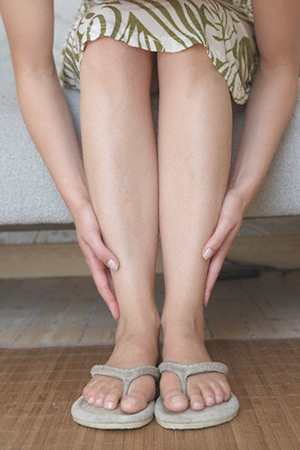A.Dovlatov, Orsha
Treatment of varicosity
 There are three main ways to treat varicose veins: surgery on the dilated veins, the application of sclerotherapy or with medication. Exercise therapy and surgical support stockings are actively used in the treatment.
There are three main ways to treat varicose veins: surgery on the dilated veins, the application of sclerotherapy or with medication. Exercise therapy and surgical support stockings are actively used in the treatment.
The essence of sclerotherapy consists in delivering special medication into the veins, which cause agglutination of the walls of a vessel and the closing of its lumina. During surgical treatment, the affected veins are simply removed. At the same time it is important to note that the removal of saphenae does not impede the flow of blood and is a safe procedure. Just 10 percent of blood normally flows through the superficial veins that are affected, while the deep veins of the legs take a much greater proportion. In the majority of cases, after surgery for the removal of varicose veins, the remaining vessels compensate easily. Remember: varicose disease can be and should be treated, as with lack of treatment it can cause unpleasant complications.
Gymnastics for veins: 15 exercises to prevent varicosity
When going on a long trip, massage your shins during the flight: squeezing and rubbing will help the blood to circulate and help to eliminate haemostasis. Be sparing in the amount of time spent in high heels, if you cannot live without them, then wear them in the office only and when going outdoors change for wedge-heeled shoes (or vice versa, depending on your preference). It is a fact that 7 and 10 centimetres heels look very similar, but the lower heels cause fewer problems.
If possible, finish your morning shower with a cold blast of water, at least on the legs if not the whole body, thus conditioning oneself to the cold and toning vessels. In general, pay attention to the legs and follow preventive activities, and the risk of vascular conditions will decrease.
Is it possible to cope with varicosity with the help of ointments or pills?
This type of treatment cannot eliminate already existing varicose veins. If a vein has dilated, then you cannot return its former form by means of gel or ointment. Phlebotrope medications are those medicines which tone the venous wall, in the form of pills or gels for local application, they are prescribed to prevent further development of the disease. While varicosity is treated only by means of procedures which agglutinate or seal a vein (or removal of this vein at the worst). Apart from phlebotonics for local application, it is possible to use cooling ointments that make the vessels contract and, thus, tone them. The role of the hereditary factor in varicosity has not been universally acknowledged, however it is necessary to consider a possible predisposition to the disease as an occasion for regular consultation of a phlebotomist. A major factor in the development of varicose veins among women is pregnancy; when planning a pregnancy one should consider the possibility of varicose vein development and take preventive measures. Along with pregnancy, obesity is also a recognised cause. Lifestyle and dietary habits also influence the condition: lack of fresh vegetables and fruit deprives the body of vegetable fibre, which is necessary for elasticity and the regeneration of vein walls.
Varicose veins — treatment and prevention
- Swimming;
- Renunciation of solarium, and also hot showers, baths and saunas;
- Rest with extended legs;
- Decrease in physical loads — stop carrying weights, do housework in a sitting position;
- Control of sports activity (tennis, cycling and football);
- Preventive consultations by a phlebotomist.
The treatment of varicosity requires a complex and individual approach to the disease. Today the most effective method is surgery — venectomy. However to achieve the best results from surgery, such auxiliary methods as medication and compression therapy are beneficial. The purpose of surgical intervention is the elimination of a pathological outflow of blood from deep veins into superficial veins and the liquidation of superficial varicose veins, thus preserving unchanged segments of vessels.
Alternatives to surgical intervention are nonsurgical techniques such as sclerotherapy of the veins, allowing the treatment of large and small veins, and also to get rid of thread veins. When starting the treatment, the patient should understand that it is impossible to get rid of varicose veins, and disease relapse is possible. But timely consultations with a phlebotomist will help to reveal the disease at an early stage — at the initial stage of the formation of thread veins. Sclerotherapy or shrinking can remove up 80 percent of defects. The convenience of the method means that sclerotherapy sessions are held in an outpatient setting, one session lasts no more than 20 minutes. It does not require a long rehabilitation period and after the session the patient can return to a normal way of life. The number of sessions varies depending on character of distribution of affected veins. On average, treatment requires 2-6 sessions.
By Tatiana Zhukova
Doctor of higher category,
M.D., Ph.D.
Doctor of higher category,
M.D., Ph.D.











